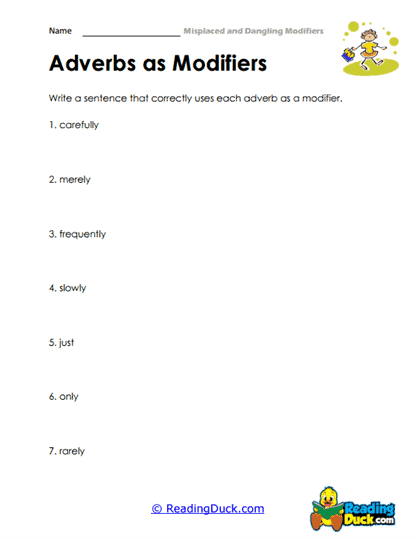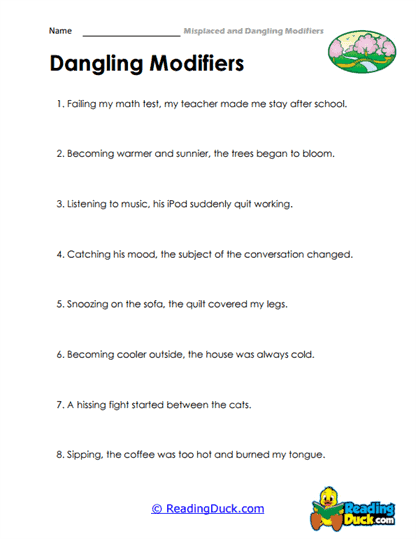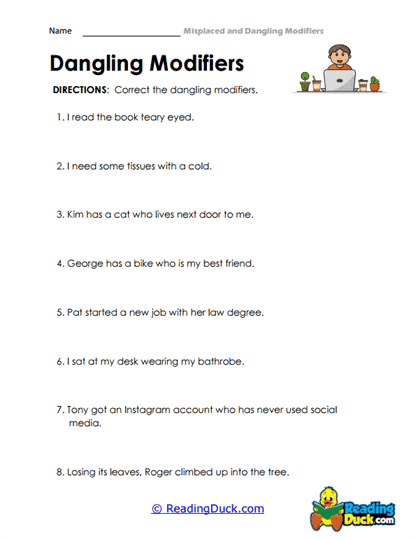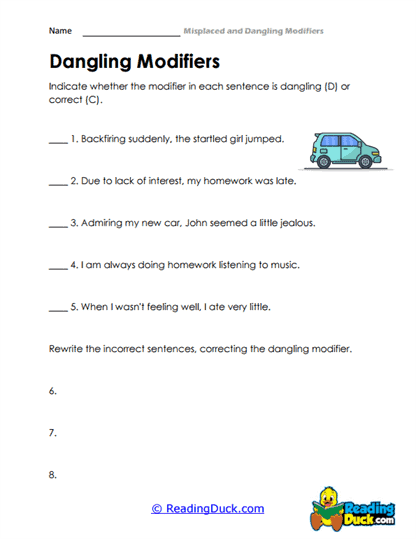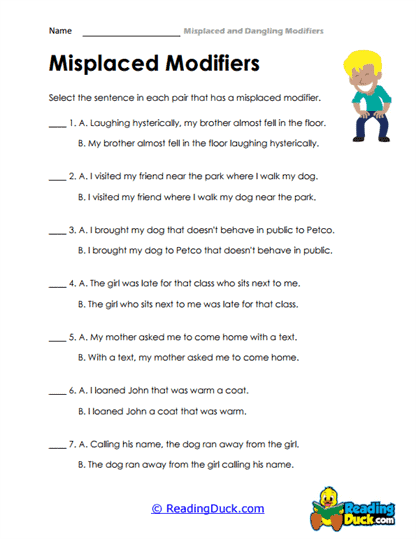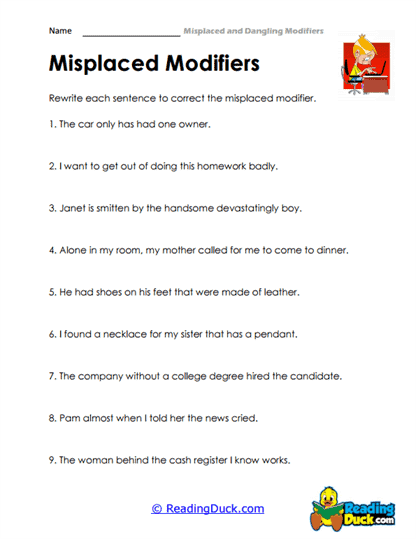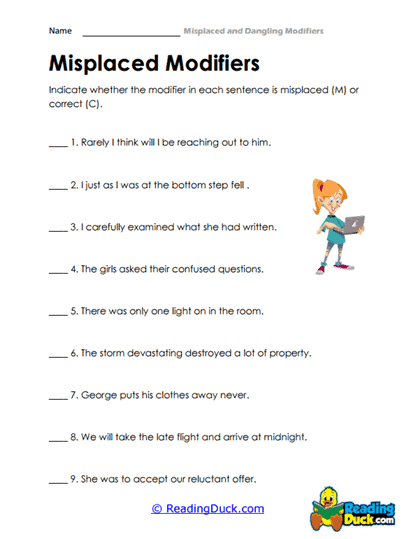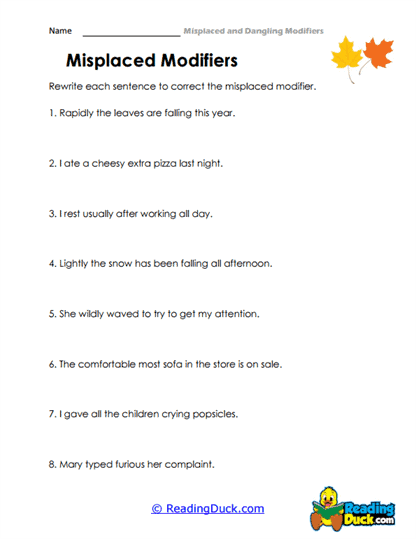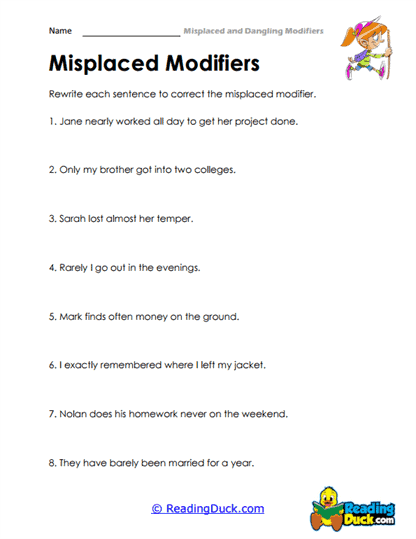Misplaced and Dangling Modifiers Worksheets
About Our Misplaced and Dangling Modifiers Worksheets
Our Misplaced and Dangling Modifiers worksheets are designed to help students recognize and correct common modifier mistakes that often lead to confusing or unclear sentences. These worksheets provide targeted practice in identifying modifiers that are either misplaced or left dangling without a clear subject to modify. By offering exercises that focus on correcting and improving sentence clarity, this collection enables students to build stronger writing skills and avoid grammatical errors that can affect the flow and meaning of their writing.
These worksheets are essential for students aiming to refine their sentence construction, ensuring that modifiers are correctly positioned to convey the intended meaning. Ideal for classroom use, homeschooling, or individual practice, these resources guide learners through understanding how to use modifiers effectively, providing practice opportunities for mastering this important aspect of grammar and sentence structure.
Understanding Misplaced and Dangling Modifiers
Modifiers are words or phrases that provide additional information about another word or phrase in a sentence. While modifiers can enhance the meaning of a sentence, they can also create confusion when they are misplaced or left dangling without a clear word to modify. Teaching students to avoid these mistakes is crucial to improving their writing clarity.
Misplaced Modifiers
A misplaced modifier occurs when a word or phrase is not placed near the word it is intended to modify, leading to awkward or confusing sentences. For example, consider the sentence:
- Misplaced: "She almost drove her kids to school every day."
- Corrected: "She drove her kids to school almost every day." In the first sentence, “almost” incorrectly modifies “drove,” which changes the intended meaning. The corrected sentence clarifies that she drove her kids to school most days.
Dangling Modifiers
A dangling modifier occurs when the word or phrase being modified is missing from the sentence, leaving the modifier with nothing to clearly describe. For example:
- Dangling: "Running to catch the bus, the rain started pouring."
- Corrected: "Running to catch the bus, she got caught in the rain." In the first sentence, it is unclear who was running to catch the bus, causing confusion. The second sentence corrects the error by introducing the subject “she.”
Key Points for Identifying and Correcting Modifiers:
- Check the placement of modifiers: Ensure modifiers are placed as close as possible to the words they describe.
- Look for missing subjects: If the sentence leaves out the word being modified, the sentence will feel incomplete or unclear.
- Revise to clarify meaning: Rearranging sentences or adding the correct subject will resolve modifier errors and improve clarity.
Understanding misplaced and dangling modifiers is essential for clear communication. These worksheets teach students how to spot these errors and guide them toward writing sentences that are grammatically correct and easy to understand.
How These Worksheets Build Essential Writing Skills
Our Misplaced and Dangling Modifiers worksheets are carefully structured to help students develop their skills progressively. The exercises start with basic identification tasks, where students learn to recognize misplaced or dangling modifiers in simple sentences. As they become more familiar with the concept, they are introduced to more complex sentence structures, helping them apply what they’ve learned to increasingly difficult examples.
Steps Toward Mastery:
- Identifying Modifier Errors: Students begin by reading sentences and identifying where a modifier is either misplaced or dangling.
- Correcting the Errors: Once students understand how to spot the mistake, they practice rewriting sentences to correct the modifier and make the meaning clear.
- Expanding Sentence Variety: As students progress, they learn how to create more varied and complex sentences while maintaining proper modifier placement, reinforcing their understanding of sentence structure.
These worksheets provide repeated practice, ensuring that students develop a solid foundation in recognizing and correcting modifier errors. Through a combination of guided examples and independent practice, students gradually gain confidence in their ability to construct grammatically correct sentences that flow smoothly and clearly.
By consistently working through these worksheets, students will enhance their writing skills over time. The exercises encourage them to think critically about sentence structure, helping them understand how small changes can significantly affect the meaning and clarity of their writing.
PDF Format and Answer Keys for Easy Assessment
Our Misplaced and Dangling Modifiers worksheets are available in PDF format, making them easy to download, print, and distribute for both classroom and home use. Each worksheet includes clear instructions and a variety of practice sentences that guide students through the process of identifying and correcting modifier errors. This format ensures that the worksheets are accessible and convenient for any learning environment.
In addition to the worksheets, each set comes with a downloadable answer key. These answer keys provide fully corrected versions of the practice sentences, allowing teachers and parents to efficiently assess student progress. The answer key not only highlights the correct placement of modifiers but also explains why the original sentence was incorrect, providing a valuable learning tool for students.
Tips for Effective Evaluation:
- Focus on Sentence Clarity: Ensure students not only correct the grammatical errors but also make the sentence clearer and easier to understand.
- Encourage Self-Assessment: Have students compare their corrections with the answer key and reflect on why certain modifiers were misplaced or left dangling.
- Offer Feedback on Creativity: When students rewrite sentences, encourage them to experiment with different sentence structures while maintaining proper grammar.
The combination of the PDF worksheets and answer keys provides a comprehensive resource for both practice and assessment. Students benefit from immediate feedback, helping them to refine their understanding and build their skills in correcting modifier errors.
Alignment with Educational Standards and Differentiated Learning
Our Misplaced and Dangling Modifiers worksheets align with widely used educational standards, ensuring that they meet the language arts objectives required in classrooms nationwide. These worksheets address key grammar skills, supporting students in achieving proficiency in writing conventions and sentence structure.
The worksheets are also designed with differentiated learning in mind. Teachers can adapt the difficulty of the exercises based on student needs, making them accessible to learners of varying abilities. For students who are just beginning to grasp the concept of modifiers, the worksheets provide basic sentences with clear, identifiable errors. More advanced students can tackle complex sentences and learn to create sophisticated writing that avoids modifier mistakes.
Differentiation Options:
- Simplified Sentences for Beginners: Use worksheets with shorter, simpler sentences for students who need extra support in identifying modifier errors.
- Challenging Sentences for Advanced Learners: Provide worksheets with more intricate sentence structures, encouraging advanced students to apply their knowledge in more complex contexts.
- Pacing and Progression: Allow students to work at their own pace, building confidence as they move from simple to more challenging exercises.
By offering differentiated tasks, these worksheets cater to a range of learning abilities, ensuring that all students have the opportunity to improve their writing and grammar skills.
Integrating Worksheets into Lessons for Maximum Impact
These worksheets offer flexible options for use in writing instruction, making them a valuable tool for teachers. One effective way to incorporate them into the classroom is by using them as warm-up exercises. Starting each lesson with a quick modifier practice activity helps students focus on sentence clarity and grammar, setting the stage for more extensive writing tasks later in the lesson.
Additionally, the worksheets can be used for review or reinforcement at the end of a unit on sentence structure or as homework assignments to provide extra practice. Teachers can also integrate them into larger writing projects, where students can apply what they’ve learned to ensure their sentences are grammatically correct and free of modifier errors.
Suggestions for Classroom Use:
- Warm-Up Activities: Begin writing lessons with a short worksheet on misplaced or dangling modifiers to refresh students’ understanding.
- Homework Assignments: Assign worksheets as independent practice to reinforce classroom learning.
- Writing Projects: Have students check for modifier errors as they revise their own writing, applying the skills from the worksheets to their original compositions.
- Group Work: Encourage collaboration by having students work in pairs or groups to identify and correct modifier errors together.
These practical applications make the Misplaced and Dangling Modifiers worksheets an integral part of writing instruction, providing students with the tools they need to become more confident and precise writers.
By using our Misplaced and Dangling Modifiers worksheets, students will develop the critical skills needed to identify and correct common grammatical mistakes that can obscure meaning and clarity in their writing. Through regular practice and the structured progression of these worksheets, learners of all levels will gain the ability to craft sentences that are both grammatically correct and easy to understand. Whether used in the classroom or at home, these worksheets provide a solid foundation for mastering the intricacies of sentence structure and modifier use.
